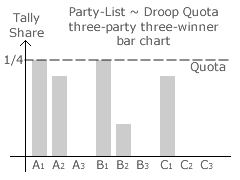Comparisons: Party-List ~ Droop Quota
Description of the Droop Quota Method
This quota method employs the largest remainder approach to seat allocation in the party-list voting system as described in the earlier party-list section. The Droop Quota is just one vote more than the Hagenbach-Bischoff Quota which is defined as the number of valid votes (V) divided by one more than the number of seats/winners (W); namely V/[1+W]. Any candidate achieving the Droop Quota of V/[1+W] + 1 is elected and any excess above this quota is transferred to the next-ranked candidate on the party list. No more than W candidates may meet this Droop quota. Where only X candidates meet the quota, the W - X candidates with the largest remainders are also elected.
For a detailed and comprehensive outline description of the Droop Quota Party-List method, please visit the voting system section of Wikipedia or another reference source.
Evaluation of the Droop Quota Properties
Before comparing this method to the party-list CHPV voting system, its own properties must first be established. As with CHPV, issues regarding optimality, party cloning and disproportionality can be addressed once a variety of multiple-party multiple-winner maps have been constructed. As the maps use tally shares (t) rather than absolute tallies (T), a per-unit version of the Hagenbach-Bischoff Quota is actually adopted instead of the Droop Quota for map construction. For per-unit tally shares (where t = T/V), the Hagenbach-Bischoff tally share quota becomes 1/[1+W]. This is independent of the actual number of voters (V); unlike the tally share Droop Quota of 1/[1+W] + 1/V.
However, on very rare occasions, the Hagenbach-Bischoff Quota is capable of electing more winners than seats. Critical ties generate such situations and it is precisely these ties that define the seat share domain boundaries on the maps. Fortunately, there is a simple solution that ensures that there is never more winners than seats. The tally quota of V/[1+W] must be exceeded (and not merely equalled) for a candidate to win. The Droop Quota (which can be equalled or exceeded) avoids having excess winners by requiring the one extra vote. The two approaches solve the same problem by a marginal difference and only very rarely yield different outcomes. Hence they are virtually indistinguishable regarding the evaluation of the properties of this party-list method.
Droop Quota Election Example

Consider again the previous three-party three-winner Hare Quota election example but this time using the Droop method and a Hagenbach-Bischoff Quota of V/[1+W]. The tally share quota is hence 1/4 of the vote (V). Parties A, B and C again respectively each receive an 11/24, 8/24 and 5/24 share of this vote. The updated bar chart opposite shows the resultant tally share for each candidate. Winning candidate A1 exceeds the quota and an excess of 5/24 is transferred to A2. Winner B1 also meets the quota and an excess of 2/24 is passed to B2. Candidates C1 and A2 therefore critically tie with the largest remainder of 5/24 with the winner here being selected at random.
For parties A:B:C, the seat share ratio is either 1:1:1 or 2:1:0 for the tally share ratio of 11:8:5. Having one seat each remains the optimal outcome as the sum of the tally share minus seat share (t - s) magnitudes (3/24 + 0 + 3/24) is still at a minimum. The outcome that favours the largest party over the smallest one is more disproportional as the sum here (5/24 + 0 + 5/24) is higher.
Droop Quota Map Construction
In the following section, the featured two-party and three-party maps for this method are presented without any explanation of their construction. For those advanced visitors to this website who wish to understand how such maps are constructed or who wish to construct ones that are not featured for themselves, then please refer to the Map Construction appendix for either the Two-Party Droop Quota Maps or the Three-Party Droop Quota Maps page.
Proceed to next section > Comparisons: Droop Quota ~ Maps
Return to previous page > Comparisons: Party-List ~ Hare Quota
